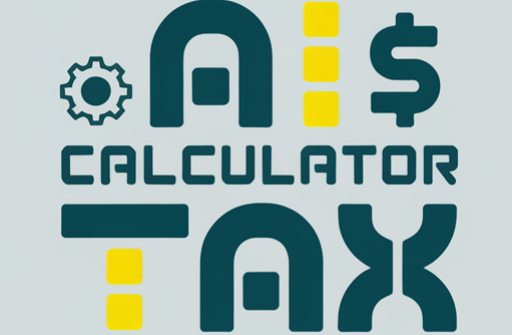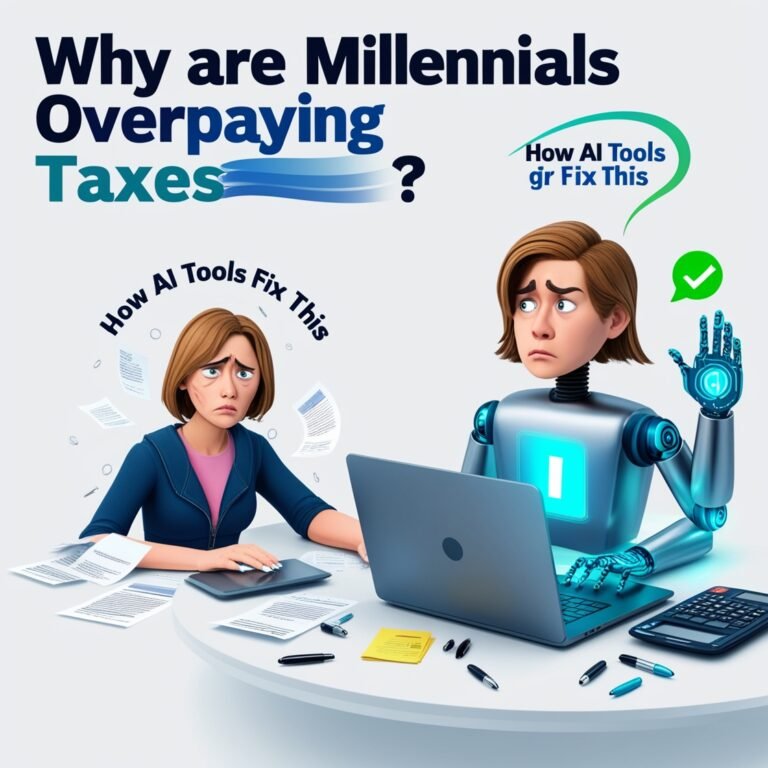Millennials (ages 28–43 in 2025) are statistically more likely to overpay taxes than previous generations. Whether it’s due to complex gig economy income, student loan deductions, or constantly changing tax laws, many young adults leave money on the table. Fortunately, AI-powered tax tools are now solving these problems with precision. Here’s how AI is helping millennials reclaim thousands in overpaid taxes and how you can too.
Why Millennials Overpay Taxes: The Top 5 Problems
- Misunderstanding Tax Brackets
Millennials often assume moving into a higher bracket means all income is taxed at that rate. In reality, the U.S. uses a progressive system. AI tax calculators auto-apply bracket logic to ensure you only pay what’s owed. - Missing Deductions and Credits
From remote work expenses to crypto losses, millennials juggle diverse income streams. Over 40% miss out on deductions like student loan interest (2,500/year)orretirementcontributions(upto2,500/year)orretirementcontributions(upto6,500 for IRAs). - Gig Economy Complexity
Side hustles (e.g., Uber, freelance coding) require tracking 1099s, quarterly payments, and self-employment taxes. Manual errors here lead to overpayment or IRS penalties. - Outdated Tax Software
Legacy tools struggle with modern tax scenarios, like NFT earnings or hybrid work setups. Millennials using these tools risk miscalculations. - Fear of Audits
Anxiety about mistakes leads to over-reporting income or underclaiming deductions.
How AI Tax Tools Solve These Problems
AI tax calculators like those at aicalculatortax.com use machine learning and real-time data to address millennials’ unique challenges:
- Automated Bracket Optimization
AI instantly calculates how each dollar is taxed across brackets, preventing overpayment. - Smart Deduction Finder
Algorithms scan bank statements, invoices, and expense reports to identify overlooked write-offs (e.g., home office Wi-Fi bills or freelance travel). - Gig Economy Tax Automation
Tools auto-categorize 1099 income, calculate self-employment tax (15.3%), and remind users about quarterly payments. - IRS Update Compliance
AI stays updated on 2025 tax laws (e.g., new EV credits or childcare deductions) to ensure accuracy. - Audit Risk Mitigation
Built-in error checks flag inconsistencies (e.g., mismatched W-2s) and generate audit-ready documentation.
Case Study: Sarah’s $3,200 Tax Savings
Sarah, a 32-year-old freelance graphic designer, used AI tax software and discovered:
- $1,100 in unclaimed home office deductions.
- $650 in student loan interest credits.
- $1,450 in overpaid self-employment taxes due to bracket miscalculations.
5 FAQs About Millennials, Taxes, and AI Tools
Q1: How do I know if I’m overpaying taxes?
Look for red flags: no refund (or a large one), unclaimed deductions, or income from multiple sources. AI tools analyze your returns to spot overpayments.
Q2: Are AI tax tools safe for sensitive data?
Reputable tools use bank-level encryption and comply with IRS Publication 4557 for security.
Q3: Can AI help with state taxes too?
Yes. Advanced tools adjust calculations for state-specific laws, like California’s gig worker protections or Texas’ lack of income tax.
Q4: What if I have crypto or stock investments?
AI categorizes capital gains/losses across platforms (Coinbase, Robinhood) and auto-files Form 8949.
Q5: How much do AI tax tools cost?
Most charge 50–50–150, but they often pay for themselves by uncovering savings. Some states offer free AI tax prep for incomes under $60k.
Take Action in 2025
Don’t let tax complexity cost you. AI tools turn hours of research into minutes of automation—and maximize your refund. Try aicalculatortax.com’s free demo to see how much you’ve overpaid in past years.
Future Trends: How AI Tax Tools Will Evolve to Protect Millennials
By 2026, AI tax software is projected to integrate predictive analytics and hyper-personalization to further reduce overpayment risks. For example:
- Real-Time Tax Liability Tracking: AI will sync with bank accounts and investment platforms to estimate yearly taxes as you earn, adjusting withholdings automatically.
- Audit Prediction Algorithms: Tools will forecast audit risks based on industry trends (e.g., crypto traders) and pre-resolve red flags.
- Voice-Activated Tax Assistants: Ask, “Alexa, did I max out my Roth IRA deductions?” and get instant answers.
Step-by-Step: How to Implement AI Tax Tools in 2025
Follow this workflow to optimize your tax strategy:
- Upload Financial Data: Connect tools like aicalculatortax.com to bank accounts, payroll systems, and gig platforms (Upwork, DoorDash).
- Run a Diagnostic Scan: AI identifies prior overpayments (e.g., 2023–2024 returns) and files amendments.
- Customize Deduction Profiles: Input life changes (marriage, home office setup) to activate tailored write-offs.
- Enable Quarterly Alerts: Get reminders for estimated tax payments to avoid underpayment penalties.
- Download Audit Trails: Store IRS-ready records (receipts, logs) in encrypted cloud folders.
Millennial Tax Horror Stories (And How AI Could’ve Helped)
Case 1: Jake, 29
- Problem: Paid $4,200 in unnecessary taxes by miscategorizing freelance income as hobby earnings.
- AI Fix: Tools distinguish hobby vs. business income using IRS criteria (profit frequency, intent) and auto-file Schedule C.
Case 2: Priya, 36
- Problem: Missed $2,800 in solar panel tax credits because her CPA didn’t ask about home upgrades.
- AI Fix: Algorithms scan connected utility bills and Zillow records to flag eligible green energy credits.
5 More FAQs About AI Tax Tools
Q6: Can AI handle taxes for expats or digital nomads?
Yes. Tools like aicalculatortax.com support Foreign Earned Income Exclusion (up to $126,500 in 2025) and tax treaties to avoid double taxation.
Q7: What if I’m repaying student loans?
AI auto-applies Student Loan Interest Deductions and identifies income-driven repayment (IDR) tax implications.
Q8: How does AI handle Roth IRA vs. Traditional IRA contributions?
It compares your marginal tax rate to recommend the optimal IRA type. For example, Roth IRAs favor millennials expecting higher future tax brackets.
Q9: Are AI tools better than human CPAs?
For most millennials, yes. AI is cheaper, faster, and less error-prone for routine filings. However, complex cases (trusts, international assets) may still require CPAs.
Q10: What’s the biggest mistake millennials make with AI tax tools?
Not updating life events (e.g., having a baby, buying a home). Always refresh your tool’s profile to unlock new credits like the Child Tax Credit ($2,000 per child).
Final Word: Stay Ahead of the Tax Game
Millennials face unprecedented financial complexity, but AI tax tools level the playing field. By 2025, the average user saves 3.2 hours per tax season and $1,900+ annually by automating filings.
Action Items for 2025:
- Audit your 2023–2024 returns with AI tools to claim refunds.
- Enable real-time tax tracking to avoid surprises.
- Share this guide with your network (group discounts often apply for referrals).
Did You Know? The IRS estimates that 20% of millennials overpay by $5,000+ over a decade. Don’t be part of that statistic let AI reclaim your money.
Conclusion
Millennials face unique tax challenges, from navigating gig economy income to maximizing deductions in a constantly evolving tax landscape. Overpayment is a common issue, but it doesn’t have to be. AI-powered tax tools like those at aicalculatortax.com are revolutionizing the way young adults file taxes, offering precision, efficiency, and peace of mind. By automating complex calculations, uncovering hidden deductions, and ensuring compliance with the latest tax laws, AI ensures you only pay what you owe—and not a penny more.
As we move into 2025, the integration of AI into tax preparation is no longer a luxury but a necessity for financial health. Whether you’re a freelancer, a small business owner, or simply someone looking to optimize your refund, AI tools are your best ally. Don’t let overpayment drain your finances—take control today.

